In the course of this present work, we have often repeated that those wondrous figures are custodians of an ancient and Traditional Knowledge. It would, however, be more correct to say that the levels of this teaching are multiple and that may be explained only through a gradual comprehension of the system of Codes which characterizes their internal, esoterical dimension. Therefore, taking into account the decryptions already demonstrated, it is possible to describe a part of that which is contained in them, examining in depth the relations that exist between them with respect to certain doctrinal subjects.
The Map of the World shows Christ in a “mandorla” ( vesica piscis ), the symbol of Christ and the four Evangelists, which appears at the entrance of many churches. Might there be a common connection between the Builders of cathedrals and the creators of the Tarot?
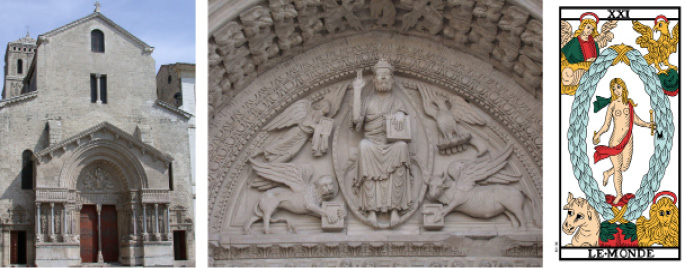
Fig. 1
The Cathedral of Arles (France)
Fig. 2
Particular of the central frontispiece
Fig. 3
The World
The many medieval cathedrals diffused across Europe are one of the most precious treasures left to us by our progenitors, and bear witness to an epoch in which man reached one of the highest points of expression. In general, we may refer back to many details of their constructions and of the successive events of which they were protagonists; and yet, on the whole, we know little of their more enigmatic and authentic significance, as our times, dominated by a rationalistic and obsessively scientific attitude, limit these masterpieces to a prevalently artistic and historical dimension.
Nonetheless, they speak to man at a much deeper level, enclosing mysteries and symbols connected to the essence itself of spiritual life. They are, in fact, coffers of wisdom, centres of universal knowledge, which, going far beyond single factions and religious cliques, belong to the entire human race. This patrimony, obscured during the Renaissance epoch by the revival of the values of Greek and Roman civilizations, and even today often neglected, expresses the extraordinary esoterical richness of the West, which draws its lymph from the culture of the Mediterranean basin and, firstly, from ancient Egypt. The Builders of these edifices, similar to actual books in stone , were certainly genial artists and able artisans, but above all, guardians of millennial knowledge expressed in symbols, able to cross centuries and cultures in order to speak to every man of God and the Sacred. Among the many mysteries of which they were custodians we find secrets of construction based on the use of the so-called Golden Number (or Number of Phi ). This is a mathematical proportion expressed by the irrational value 1,648(...) obtained from the equation: (√5 + 1)/2. Although it was thought that this relationship was defined for the first time by Euclid, three centuries before the birth of Christ, analysis of the mathematical knowledge of the ancient Egyptians has led many researchers to assign to them not only the discovery but also the deep cosmological significance. This section, called Aurea, may be obtained dividing a segment of a straight line in 2 unequal parts so that the entire length is to the longer part as the same is to the shorter. Let us take the segment and divide it into the C point:
A______C___B
The AC segment represents the Golden Section of AB if it satisfies the condition:
AB: AC = AC: CB
In practice, in order to technically apply this proportion, it is sufficient to divide a first length by 1,618 in order to obtain a second. The two measures, if used in construction, generate a special harmony and, according to some theories, create a particular syntony, which predisposes humans to the perception of superior vibrations. This is a phenomenon known for thousands of years and Builders of cathedrals, to name but a few, have used them in a systematic manner.
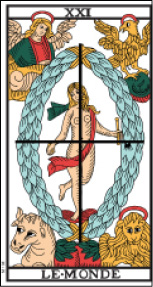
Fig. 4
Rapport Length - Width
What is the relationship with the Icons? Even the Marseilles Tarot of Nicolas Conver was engraved with the above-mentioned geometrical concept which, expressed in several ways in all of the cards, contributes to codify certain messages and to render sacred the entire content. For example, referring to the symbol of Christ in the Mandorla described by the World, we will not be surprised to rediscover the Golden Section in the height and width of the oval, whose division, tolerating a slight deviation owing to the techniques of the 1700’s (which might have caused a minor possibility of definition on a millimetrical scale), leads precisely to the value of 1.618(...). All this, on the one hand reinforces the idea of a relationship with the Builders and on the other, prompts reflection on the use of this proportion and its extraordinary characteristics.
Freemasonry is an initiatic Order whose members strive for the moral and spiritual elevation of man and of the human family. Its nature and that of its institutions is humanitarian, philosophical and moral, its purpose being the perfection of the individual. Its members, the Freemasons (from the French franc-maçons), were originally called Stonemasons. Their origin seems to be connected to the association of workers in the legend of Hiram Abif, the chief architect of the construction of the Temple of Solomon. 103 These works were carried out well before the I century AD and therefore the Freemasons seem to have quite ancient roots. We refer to these facts merely to avoid the temptation to propose dating the Marseilles Tarot to the XVII or XVIII century, maintaining that, the Freemasons having appeared only in that period, a more remote genesis of the Icons would be anachronistic. In truth, a precise temporal indication is impossible, as originally these Orders were so secret that they continue even today to be surrounded by mystery. Modern Freemasonry considers itself the operative and active heir of the Masonic Tradition, and for this reason, its symbols mirror the ancient ones in such an evident manner. It has been amply demonstrated that among operative Masons there exists an esoterical preparation, as it involves brotherhoods whose perspective, beyond the strictly professional areas, touched the spiritual sphere. These men together attempted to reach the highest ascetic perfection, carrying out their work with great integrity; and the same tools used in their daily lives became the symbols of their quest. It is thus that the square and the compass became the great emblems of Freemasonry and these, as are many other Masonic elements, are to be found also in the Marseilles Tarot. The Tarot, therefore, is the depositary of the Science of the Great Architect of the Universe 104 and describes the initiatic Path of the Builders of times past.
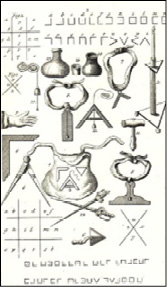
Fig. 5
Masonic symbols
The Square and Compass are among the better-known symbols because they express, with admirable synthesis, the entire itinerary from Earth to the Heavens. The first, in fact, allows us to draw the square rectangle, which symbolizes the terrestrial; the second is used to draw the circle, the celestial. If we observe the Bateleur (I) and the World (XXI), that is, the beginning and the end, we find the form of the square rectangle in the table and that of the oval circle in the mandorla.
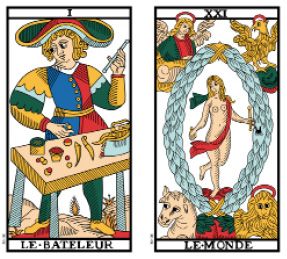
Fig. 6
The Magician
Fig. 7
The World
This is a confirmation of Dualism, which demonstrates yet again, that along the Way of the Tarot we proceed from the squared square to the circle compass, from Earth to the Heavens, from the personality to the Soul. If we wished for more confirmation, we might pinpoint this symbolism, not only at a conceptual and allegorical level, but at a graphical level as well. Where should we look? Let us take, as an example, the Emperor:
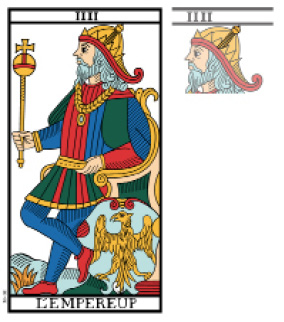
Fig. 8
The Emperor
Fig. 9
The Compass of the Emperor
On his helmet is a compass of which we see only one branch. In Freemasonry, the diverse distributions of its areas with respect to the square describe the so-called three administrative degrees:
• The Entered Apprentice: compass behind the square. Prevalence of the terrestrial.
• The Fellowcraft: alternating compass and square. Terrestrial-celestial equilibrium.
• The Master Mason: compass in front of the square. Prevalence of the celestial.
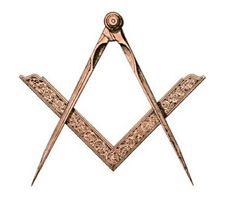
Fig. 10
Square Ruler behind the Compass:
Degree of Master
In the card, as one of the arms is hidden, the Emperor-Builder is a Fellowcraft who “ explores the terrestrial globe, ” that is, investigates the Material. His gaze, in fact, is fixed on the symbol of the tripartite circle surmounted by a cross, which symbolically represents the Earth. To confirm the hypothesis of a connection with the Freemasons, among other and more complex details, contributes the particular disposition of the legs as well, whose relationship with a square is obvious. In the same Arcanum, therefore, we find several elements, which, through different encryptions, lead back to the same notion.
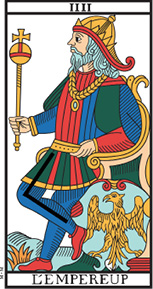
Fig. 11
Emperor and Square Ruler
These described are only certain examples of the two best-known Masonic symbols. Many other elements are hidden in the Icons but encoded under more subtle forms, a few of which we will now analyze.
In the Mantegna Tarot 105 , an ancient Italian deck, the first Arcanum is the “ARTIXAN”. The name is not casual, and recalls the iconography of the Magician, Arcanum I, an artisan who utilizes the tools spread out on the table. This symbolism, similar to that of initiatic fraternities, describes again the Path which the pilgrim travels from the level of Apprentice-artisan towards that, first of Fellowcraft, then of Master Mason.
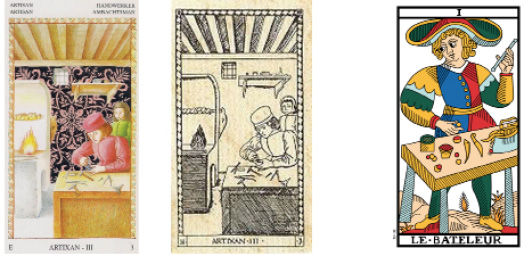
Fig. 12
The Artixan of the Mantegna Tarot
Fig. 13
The Magician - Artisan
The Three Points in a Triangle
The three points in a triangle, used in Freemasonry to abbreviate words, according to their different disposition also express the symbolism of the four elements:
• Earth is associated with the equilateral triangle;
• Water, to the right triangle;
• Fire, to the isosceles triangle;
• Air, to the scalene triangle.
In the Tarot, we find the three points in an equilateral triangle in the Devil, on the chest of the small personage on the left. This indicates that the two acolytes, under the demon’s influence, find themselves in a primitive and terrestrial condition, as suggested by their animalistic characteristics (tail, horns, claws, etc.). At the same time, remaining in the Masonic sphere, from the presence of the cord around their necks we understand that the two subjects are candidates for initiation. In this stage, they must still overcome certain temptations because they are prisoners, as are all human beings during the course of their process of evolution, of the influence of that which is more earthly and material. Only when purified, in fact, will they be free to enter the Temple, as shown in the Tarot itself, in which the House of God (card XVI), the equivalent of the Temple, follows immediately after the Devil (card XV).
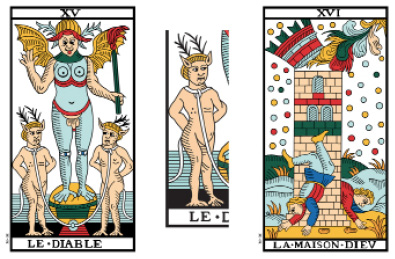
Fig. 14
The Devil
Fig. 15
The 3 points in an Equilateral Triangle
Fig. 16
The House of God - Temple
Furthermore, when the two Fellowcrafts liberate themselves from the action of the Prince of the Earth, in the card of the Sun they transform into evolved and humanized beings. We are certain of this deduction because on the chest of the personage on the right there are the same three points present on the Devil. In this case, however, they are arranged in an isosceles triangle, to affirm the purification attained through Fire, precisely in the Arcanum which reveals the most evident relationship with Fire par excellence , that of the Sun.
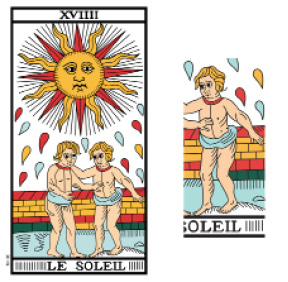
Fig. 17
The Sun
Fig. 18
The 3 points in an Isosceles Triangle
The Fool, the disciple along the spiritual Path, proceeds in the direction of the Hermit who, at a certain level, is the Master. Their relationship is confirmed by the presence of the red wand, which symbolizes their belonging to the same Order. 106
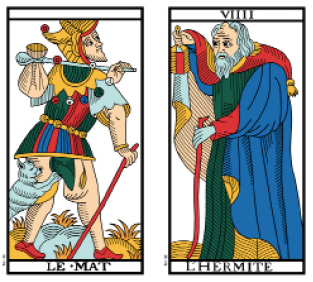
Fig. 19
The Fool
Fig. 20
The Hermit
At the same time, the Fool holds another wand in an uncomfortable and unnatural manner. As his left hand, because of this position, rests on the right shoulder, we see a codified sign of recognition. The Tarot handed down by Conver in 1760, in fact, not only possesses a particular relationship with Freemasonry and the Order of the Temple, but is specifically connected to the Ancient and Accepted Scottish Rite, the most elevated of the Masonic path. We are not affirming that it was created by the Freemasons of the Scottish degree; rather, that the transmitted message is shared. As the Scottish Rite is one of the Sovereign Initiatic Orders and is articulated in 33 degrees, let us investigate the symbolism more deeply in order to give solidity to our suppositions.
Let us look again at the Fool who, as we already know, has a special role because of the card’s lack of a number. The research begins with him; he is the guide who leads our Soul towards other firmaments and new planes of consciousness; he is the door into the world of the Tarot. Analyzing his staff more attentively, we note that, not only does it establish an angle of 30° with the vertical; moreover, it is not rigorously straight: it is made, in fact, of two straight sections, which create between each other an angle of 3 degrees, which, together, form 33...
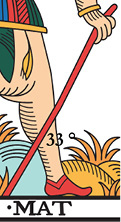
Fig. 21
The wand of the Fool
There is no doubt: at the beginning of the Path of the Tarot, the symbolism of the 33 degrees, constituted by the 3 initial administrative degrees (Entered Apprentice, Fellowcraft, and Master Mason) plus the successive 33, is already announced...
3°
+ 30° = Les 33 degrees of the Ancient and Accepted Scottish Rite
This example offers as well the opportunity to repeat that the teaching of the Tarot is harmoniously developed on various levels. The Codes express, simultaneously , diverse hidden meanings which allow us to reconstitute a Science (on an esoterical, philosophical, and theological level) containing the knowledge preserved by the Ancients. Remembering that the fundamental characteristic of this sort of multidimensionality is Coherence, it is possible to demonstrate the existence not only of Dualism, but also of Numerology, Astrology, esoterical Psychology, and many other complex disciplines, prerogative of higher levels of Initiation.
Speaking of the Builders and Freemasons, we have mentioned a connection with Egypt, already an object of analysis in the description of the High Priestess and her rapport with the Goddess Isis. In order to analyze this relationship we must confront a new concept, that of the so-called “ Codes of the dualistic symbols ”. These are a mechanism of codification for discovering the presence of two distinct elements which, when united, generate a third and different element. Let us offer an example of clarification.
Wishing to connect Astrology and Tarot, many authors have attempted to associate every zodiacal sign to a single Major Arcanum. Fortunately, this correspondence is much richer and more complex while remaining, at the same time, paradoxically, quite simple. Let us attempt to observe attentively the following image.
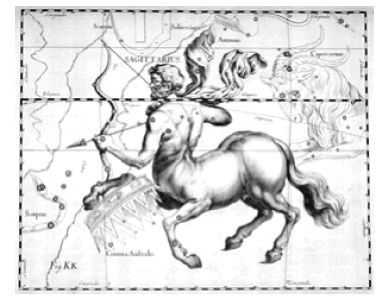
Fig. 22
The astrological sign of Sagittarius
It is Sagittarius, the centaur with bow and arrow. Following the principle of codification just described, in the Tarot we obtain this zodiacal sign associating the bow and arrow in the Lover (element 1) with the man-horse in the Chariot (element 2):
Bow-Arrow
(element 1) + Centaur (element 2) = Sagittarius (element 3)
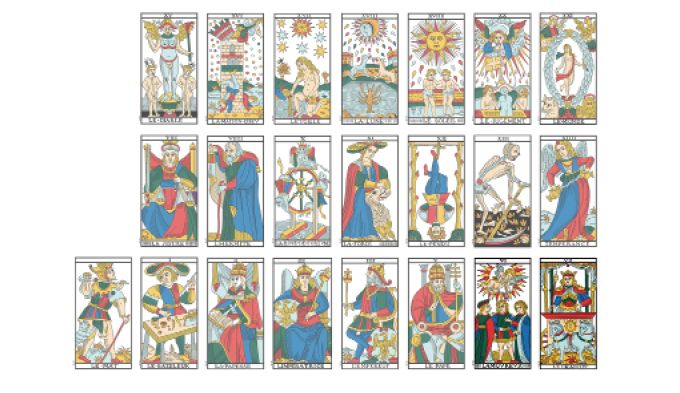
Fig. 23
The 3x7 Diagram
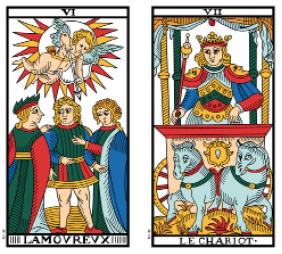
Fig. 24
Particular of the Sagittarius
This example (we will elaborate on the astrological knowledge of the cards in another context) demonstrates that the above-mentioned rule, according to which certain symbols are hidden by a method of fragmentation into two separate factors, is simple but extremely well hidden. Returning to the subject of Egypt, let us try to apply the same procedure, keeping in mind that our field of research remains in the area of the sacred. Which are the two most important elements in the card of the Fool?
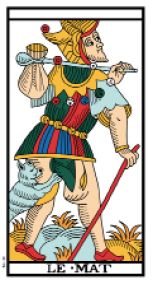
Fig. 25
The Fool
Reflecting, and considering that all that is illustrated (and it is not obvious...) is symbolic, we see the human and the dog. These, apart from any other consideration, are the most relevant because they are not inanimate but living. What representation may we reconstruct from these two factors? It is Anubis, the dog-headed God:
Fool
←→
Anubis
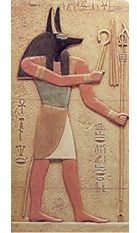
Fig. 26
Anubis
Although some will think of the jackal, actually they both belong to the same animal family and there is no contradiction, even in light of the fact that in the most ancient cult, the first representation of Anubis was with the head of a dog. Moreover, the surprisingly similar posture, and the presence of the two staffs, is remarkable. Between these subjects, in fact, there exists a close correlation which, for its importance and complexity, we will develop in more detail in the future. For the moment we will reveal in advance that in the Arcana are hidden the symbolisms of other Egyptian deities whose presence reinforces the hypothesis of a clear connection with this Tradition. As confirmation of our reasoning, we offer another example: the Strength card.
Let us observe the card in order to understand the two elements useful for the sort of codification proposed. With an eye already trained by the example of the Fool, it should not be difficult to individuate the woman and the lion. Which Egyptian deity will derive from the union of these two? For Egyptology enthusiasts the answer should appear obvious: it is Sekhmet , the lion-headed woman whose name means “She who is powerful”, precisely as in Strength. Sekhmet , represented with divine symbols such as the sun disk and the ureo , the corona, the representation of the serpent, was the terrible war goddess who, personifying the rays of the sun, of a deadly heat, incarnated the destructive power of that heavenly body. That is why, on the hat of the Arcanum XI, in a manner now more comprehensible and evident, we find scales (a reference to the skin of the reptile), but also the yellow rays of the sun.
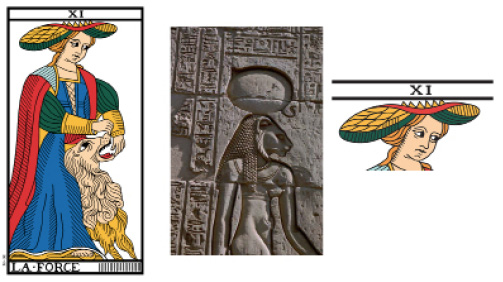
Fig. 27
The Strenght
Fig. 28
Sekhmet
Fig. 29
Scales and Rays
These codes, therefore, confirm the close relationship between the Tarot and Egypt. Why is this connection so noteworthy? Describing the history of the Icons, we have remarked upon the existence of a connection with the monk John Cassian, he himself connected to the Holy Hermits of the desert, the Fathers of the Christian church. Let us examine further this relationship.
Officially, the first hermits date to the III century AD. Following the persecutions that they had undergone, authentic Christian practices were in danger and Saint Cassian, who had spent many years in their company in the desert, brought back to the West the teaching so opposed by the authorities of the Roman Empire. Following his protracted Egyptian experience, he established himself in Provence, where he founded the Abbey of San Vittore, developed and diffused a re-elaborated monasticism on the Oriental model. As his knowledge would have been judged heretical, in order to transmit it he was obliged to utilize in his texts, codes similar in their mechanism to the dynamics of the Coded Structure of the Tarot. For example, in the preface of the “Cenobitic Institutions”, one of his more relevant works, in the first paragraph of the text he mentions, in the very first sentence of the book in fact, King Solomon, and establishes a connection with Hiram Abif, the Architect of the Temple, comparing himself directly to him:
“The Old Testament story narrates that the most wise Solomon (...) when he had the intention to build that famous and magnificent temple to the Lord, asked for counsel from a foreigner, the king of Tyre. And Hiram, son of a widow, (...) having been sent to him; with his help and council was able to fulfil all that beauty that divine wisdom suggested to him to prepare in the temple of the Lord or for the sacred furnishings. (...)
As you also, most blessed Pope Castor, have in mind to construct for the Lord a true and spiritual temple, not with inanimate stones but with a community of holy men, a temple non temporal or corruptible but eternal and impregnable and as you desire to consign to the Lord precious vessels (...) you then have deigned to call to participate in such a great work as this, myself, who am needful and poor from every point of view. 107 ”
With this citation Saint Cassian manifests an explicit connection with the Freemasonry; as the Temple of Solomon, considered by the Judaic-Christian Tradition, the first Temple of Jerusalem, symbolically represents the Temple to which adhere the Freemasons who see in Hiram the figure par excellence of the Grand Master. 108 With this comparison, therefore, he states his mission to integrate into the West, where monasticism at this point had become corrupt, the knowledge preserved for centuries in the Egyptian monasteries and to which Freemasonry itself was heir.
We could mention many other examples present in his texts, but that which is important now is to understand that Cassian, through coded messages, affirmed the transmission of an Egyptian-Christian matrix which from the Hermits (who according to him were present already in the I century AD and directly connected to the Apostle Mark from whom they had learned the Rule 109 ) had to us. The scrolls found at Nag Hammadi in 1945, the so-called Gnostic Gospels, are considered a concrete demonstration of this truth and, for however strenuously contrasted by ecclesiastical authorities of the epoch and today considered apocryphal (in the sense of non-canonical), represent the proof of the intense activity of primitive Christian groups in the region. The Egyptian initiates welcomed the nascent Christianity and the ancient knowledge was integrated and renamed, clothed in the new doctrine. Official history calls them Kadosh , or Saints as, living in solitary and inhospitable regions, they were the perfect depositaries of the ancient Tradition directly descended from the Builders of the Temple of Solomon. For this reason, in Freemasonry the 30° degree of the Ancient and Accepted Scottish Rite, one of the highest one can reach along the Path, is called Kadosh .
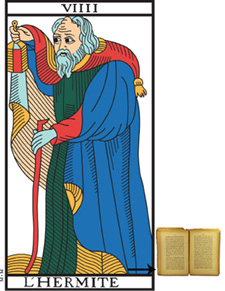
Fig. 30
The book of the Hermit
In a context in which Egyptian Tradition, Christianity, Hermits, Builders of the Temple and Freemasons find themselves wholly interconnected and apparently with a same common root, the Icons of the Tarot, of which Cassian and his order were such excellent guardians. It is therefore coherent to find in the Tarot this mixture of Egyptian and Christian traditions (whose iconography is sufficiently explicit to not require particular decryption at this time) 110 , as well as the symbolism of the Builders and Freemasons. A relatively evident example follows. Which card would represent the anchorite? As the name itself suggests, it is the Hermit. This Arcanum, on the one hand symbolizes the Fathers of the Desert, as indicated by the presence of soil, yellow as the desert, at his feet; on the other, for his staff, to relate to the staff of the Fool (whose symbolism leads back to the 33 Masonic degrees), symbolizes the Kadosh , the 30th degree of the Scottish Rite. It is no coincidence that, in the folds at the bottom of his robe, he hides an open book, partly covered by the robe itself. This hidden symbol uncovers the close relationship with the arcane Knowledge that the Fathers of the Church, the ancient Egyptian hermits, secretly received and kept safe. 111 On the whole, therefore, the Tarot is depositary of the teaching which leads directly back to the Builders of the Temple and which was perpetuated in Provence by men such as Cassian and Onorato (founder, upon the model of the oriental monasteries, of the monastery of Lèerins, and Bishop of Arles from 426 AD). For this reason, until the appearance of the Inquisition and of the Dominicans who flaunted their influence, it was the Cassianites (or Cassinites) first and the Benedictines later (Cassian was one of the spiritual teachers of Saint Benedict) who spread this knowledge, whose alchemical and occult symbolism is coded in the Tarot and in churches and cathedrals throughout the Western world.